
In October, 2021, Connecticut-based builder Ben Bogie of BPC Green Builders broke ground on a trailblazing project in the Hudson River Valley (climate zone 5). A collaboration with Trillium Architects, the 5000-sq.-ft. net-positive house is Japanese-inspired in design and building science–focused in construction. Keeping upfront carbon emissions to a minimum is a prime objective. The project minimizes the use of virgin foam insulation, reduces concrete where feasible, is engineered to avoid the need for steel, and optimizes materials made of recycled content. GBA is following the build and sharing key construction details along the way. (See Episode 1 of a 10-part video series covering this high-performance build.)
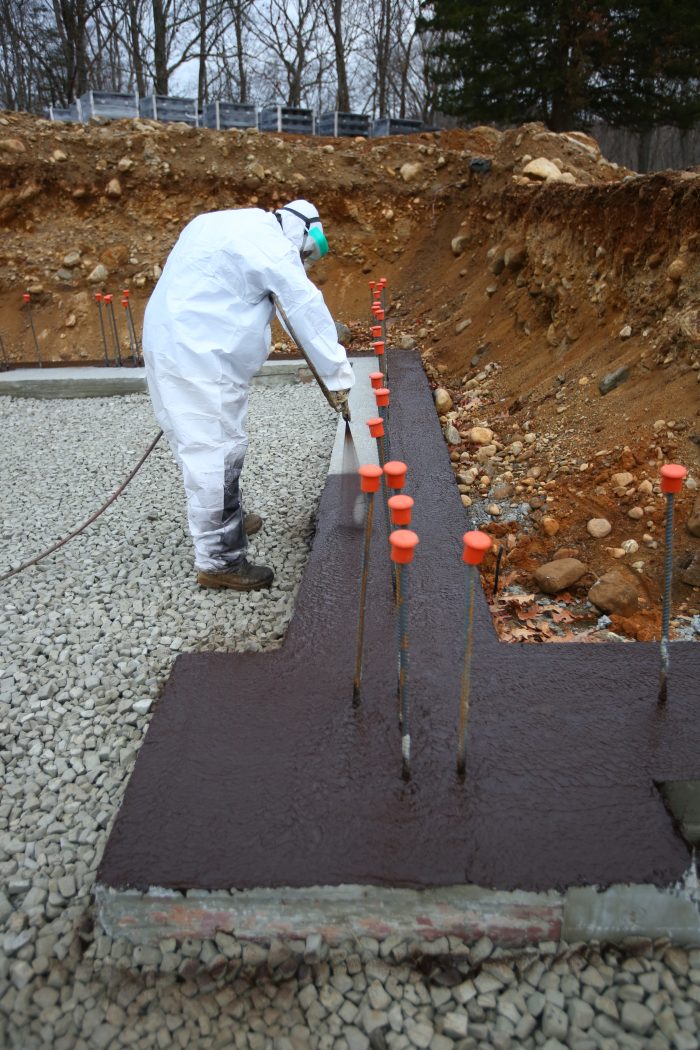
The first detail of note is the way they handled the capillary break at the 12-in. by 24-in. cast-in-place monolithic concrete footings, which include two horizontal rebars and 5/8-in.-diameter vertical rebar every 24 in. (substantially more rebar than most footings). Because the footings sit directly on soil and will wick water, it is critical to create a capillary break to prevent moisture from traveling into the foundation walls and potentially moving into the interior environment; this capillary action is the reason moisture accumulates on the backside of insulated foundation walls—a situation that can lead to high humidity, mold growth, and musty smells.
The capillary break is achieved with Tremco’s Tuff-n-Dri fluid-applied waterproofing membrane at the top of the footings. After the footings are poured, they are allowed to set for a few days before work on the foundation walls begins. It is during this short break that a waterproofing subcontracting company (the same company that will waterproof the foundation walls) arrives to spray the membrane on the stripped footings. Ben says it’s fast and cost-effective. It took an hour-and-a-half to cover all footings. He also says it works well in an assembly with so much rebar. The alternative peel-and-stick membrane method would require a lot of cutting to get it around all the rebar penetrations—a significant increase in labor costs and, arguably, a less effective measure, given the disruption of continuity that cutting the membrane creates.
“When looking at a high-performance building, we want to control all the energy flows throughout,” Ben summarizes, “and one of them is the passage of water vapor and water, so we start at the lowest point in the assembly. We start controlling the forces there. The capillary break is the first step. If you leave that unaddressed, there is a pathway for water to get up through the foundation wall, which can affect the indoor environment.”
_________________________________________________________________________
Kiley Jacques is senior editor at Green Building Advisor. Illustration by Patrick Welsh. Photo by Brian McAward.
Weekly Newsletter
Get building science and energy efficiency advice, plus special offers, in your inbox.





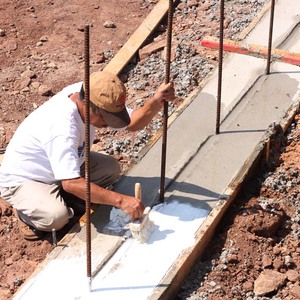
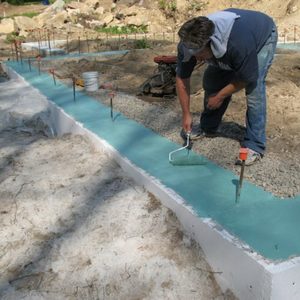
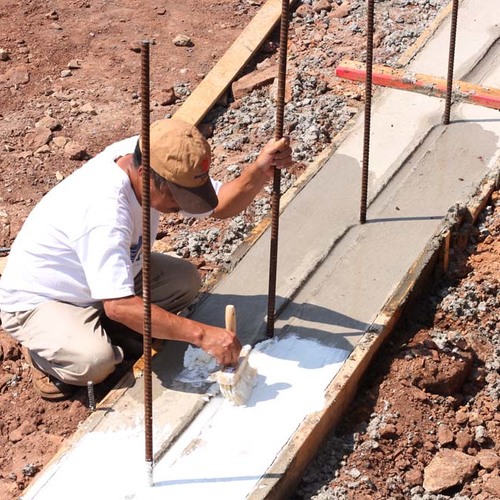
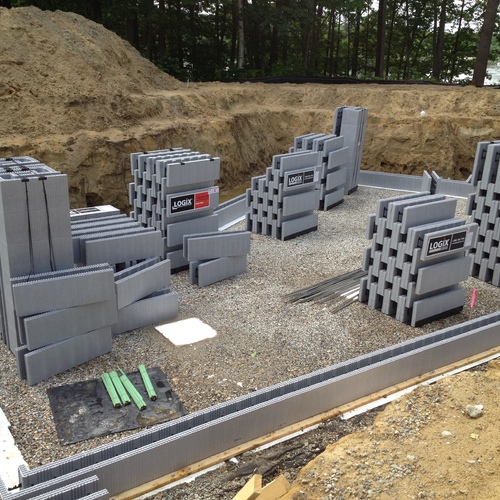






20 Comments
Many soils in the country require a keyway on top of the footing. You can create a “V” or square channel after the footing is smooth-out. This groove allows the wall concrete to set and form a mechanical connection on a cold joint, and prevent the wall from sliding across the footer with high horizontal/lateral forces, especially if you are building on expansive soils or on the side of a hill or mountain.... Required or not, I think it’s always a good idea.
Hi Armando,
Ben intentionally omits that feature in favor of this method, which doesn't require it.
Armando,
I always saw the key-way and rebar as either/or connections which both serve the same purpose countering shear forces at the joint. Rebar has the added advantage of also allowing the structure to act monolithically against vertical and horizontal forces.
Would not a water proofing Concrete Sealer, of which there are many, sprayed from a common garden sprayer be cheaper, easier, and just as effective. ?
“[Deleted]”
The sealer should be compatible with the forms. Some sealers will eat forms with foam in them. Water based sealers are required for foam based forms.
When I hear the term “sealer” I usually think of that as the ones that are used on exposed decorative concrete. Like you said, they are often applied from a garden sprayer. Those types of coatings are meant to offer some protection from liquid staining and offer some level of “waterproofing” in the sense that they promote beading on the surface. They do not in fact waterproof and they do not resist the movement of water vapor or high hydrostatic pressure, two things that we need in order for this detail to be effective.
Ben, I don't mean to be argumentative as I'm really trying to determine why a "sealer" can't be used since it is so much cheaper and easier. I'm working on that "effective". I agree that the sealer's are not water proof but they do resist water substantially unless the water sits on the sealer for lengthy periods. For use as a capillary break on the footer, or on top of the stem wall, I can't see that there would be "high hydrostatic pressure" as what we're preventing is, what I imagine to be, a very slight pressure, if any, that of the rise of water due to capillary action, which is due to molecular bonds, not hydrostatic pressure. Is that not true ? I don't know what the permeance of sealers is but it seems to me that they would not have to have an exceptionally low permeability in order to prevent most water vapor transmission and be effective as a capillary break. I'd appreciate enlightenment.
“[Deleted]”
I read an article, I believe it was one from Building Sciences, that it's hydrostatic pressure that drives the water through the footing and the cold joint with the foundation wall. I see this as one of the things that can't be done after the foundation is poured and the consequences of failure are extremely difficult and expensive to fix. It's cheap insurance.
I don't really think a sealer applied with a garden sprayer is so much cheaper than Tremco Tuff N Dri or Henry CM100, but that's just my opinion. This would not be a place I would chose to try to save money. I'd rather take it out of the counter tops or built in cabinets or trim moldings.
Allan, I agree that the hydrostatic pressure of groundwater will drive water through concrete. But as I see it, that's a separate issue. If one relieves hydrostatic pressure, as one should, (dimpled membrane, gravel, or other) that allows water to drain freely downward to the drainage system alongside the footer, then hydrostatic pressure is not an issue. That brings us back to the separate issue of the capillary break between the footer and the foundation wall that sits upon it. With the issue of hydrostatic pressure eliminated, we have only to stop capillary action of moisture in the footer from rising into the foundation walls. And that requires a narrow strip of material, as wide as the thickness of the foundation wall of the appropriate material. My question is: Would not a common inexpensive concrete sealer sprayed from a garden sprayer be effective ? Surely the labor and cost of materials for the waterproofing material in the article above with protective gear, pumps, nozzles and contractors is markedly higher than the garden sprayer with concrete sealer. I could keep it in the back of my truck and upon completion of the pour it would only require a couple minutes to hop out and spray all of the necessary area. It seems like my question comes down to the issue of effectiveness of the concrete sealer providing a capillary break.
When I look at the picture in the article I wonder why he is spraying the entire top of the footer, as the only area that requires a capillary break is the narrow strip on which the foundation wall sits. To me, it seems the picture represents a waste of time, labor, and materials. Spraying the entire top of the footer doesn't seem to achieve anything, though it does look neat. If a concrete sealer is effective, then it's got to be quicker, more convenient, cheaper and easier.
Ted,
One potential problem is that most the sealers I've used have to be applied to cured concrete. I have used Cure&Seal, but I suspect it is designed to provide surface protection, while still allowing moisture to move through it. Maybe something like Drylok would work?
I agree with you that it makes little sense to do the whole top of the footings.
https://www.greenbuildingadvisor.com/article/capillary-breaks-above-footings
I think you are underestimating hydrostatic pressure. Although the flow is across a narrow area, thus not much "total" pressure, and the volume is low--the PSI is probably significant.
Scott,
I don't think Ted is dismissing the strength of hydrostatic pressure, he is saying that's not what the capillary break is for. It's to stop water movement up into the concrete stem-wall cause by a different mechanism - capillary action.
As per that link, when I contacted Henry about Blue Seal as a footing capillary break they responded with this:
"Thanks for your interest in Blueseal, yes you can use Blueseal in that application. Let us know if you have any other questions.
Christopher Benoit | Product Support Rep | HENRY COMPANY | 336 Cold Stream Road, Kimberton, PA 19442 | P 800.486.1278 | http://www.henry.com"
"If a concrete sealer is effective, then it's got to be quicker, more convenient, cheaper and easier."
I'm not convinced it's as effective and I'm not willing to take the chance that it is, but that's just my opinion and decision on where to spend. Of course, YMMV. There are many areas of a build that could be cheaper. Like spray foam insulation. We could just stuff fiberglass bats in the rim joists to save money, but again, I will decide not to and use spray foam in the rim joists. Everyone could use fiberboard sheathing as well because it's cheaper.
There are always other ways and often cheaper ways to do things than the articles here outline. I appreciate reading them and then deciding what I want to do. I also appreciate members commenting and questioning like you do, Ted.
Wasteful and expensive: my choices would be to concrete sealer or MasterSeal 583 Formerly Super Thoroseal.
Green building solutions are usually a compromise between environmental impacts, cost and availability . While I appreciate the effectiveness of the liquid-applied membrane, reading the SDS sheet gives me pause. It is primarily a petroleum product and apparently quite toxic. Is there not a less toxic. liquid-applied membrane without as much carbon content?
Tremco makes a product.Tremco 250 gc similar to Tuff and ri designed to go on green concrete
https://www.tremcosealants.com/markets/commercial/waterproofing-systems/cold-fluid-applied/tremproof-250gc/
Most structural engineers these days don’t insist on keyway anymore rebar offers at least as robust lateral support and obviously better vertical support(essential in seismic areas, heaving Texas soil, etc) (tip -rotate every other L bar in footer 180 degrees so you are getting support from the wall leaning in OR out!) for most residential footers (not that wide) a narrow keyway formed by sliding a 2x4 on edge does not leave much of a “key” or A “way” , and as a cold joint it’s liable to crumble fracture. A bit even without much movement . But why not prevent moisture from even getting into the footer in first place ?? Wrap you subslab vapor barrier ply stego etc UNder the footer a la fast foot footer //,
Deuce,
I mentioned Tremco TremProof 250 GC in my article on this topic. For more information, see "Capillary Breaks Above Footings."
Log in or create an account to post a comment.
Sign up Log in